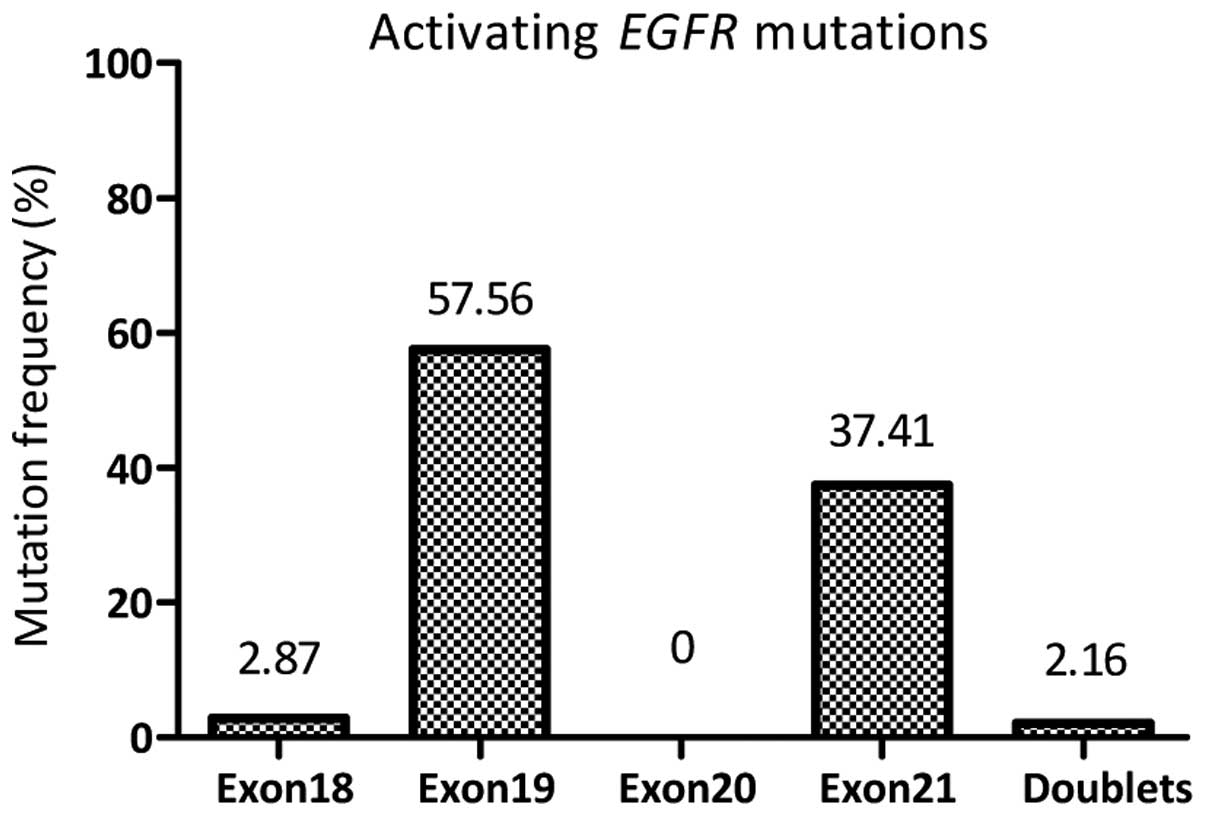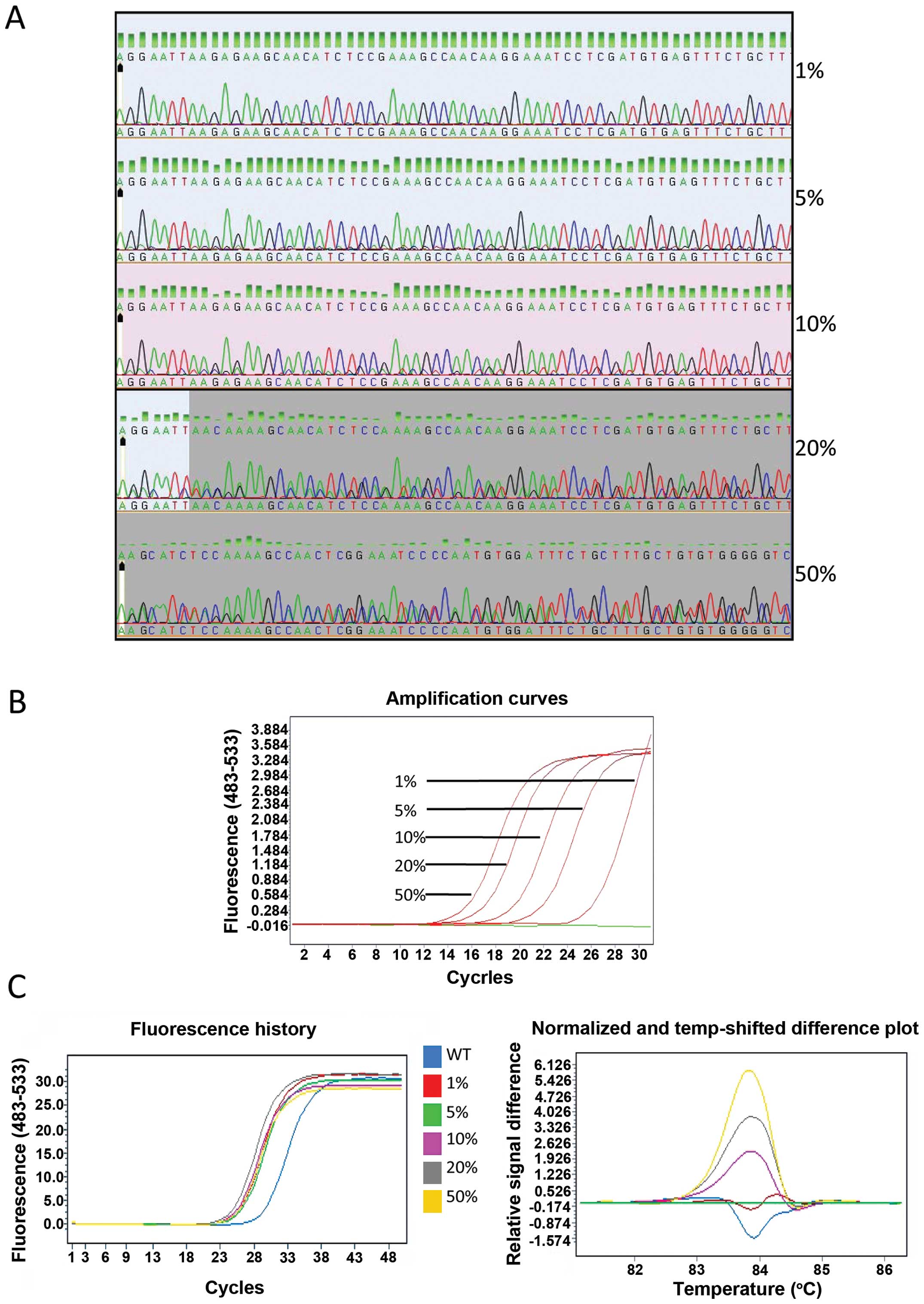|
1
|
Lynch TJ, Bell DW, Sordella R, et al:
Activating mutations in the epidermal growth factor receptor
underlying responsiveness of non-small-cell lung cancer to
gefitinib. N Engl J Med. 350:2129–2139. 2004. View Article : Google Scholar : PubMed/NCBI
|
|
2
|
Paez JG, Jänne PA, Lee JC, et al: EGFR
mutations in lung cancer: correlation with clinical response to
gefitinib therapy. Science. 304:1497–1500. 2004. View Article : Google Scholar : PubMed/NCBI
|
|
3
|
Sharma SV, Bell DW, Settleman J and Haber
DA: Epidermal growth factor receptor mutations in lung cancer. Nat
Rev Cancer. 7:169–181. 2007. View
Article : Google Scholar : PubMed/NCBI
|
|
4
|
Lopez-Rios F, Angulo B, Gomez B, et al:
Comparison of molecular testing methods for the detection of EGFR
mutations in formalin-fixed paraffin-embedded tissue specimens of
non-small cell lung cancer. J Clin Pathol. 66:381–385. 2013.
View Article : Google Scholar : PubMed/NCBI
|
|
5
|
Ellison G, Zhu G, Moulis A, Dearden S,
Speake G and McCormack R: EGFR mutation testing in lung cancer: a
review of available methods and their use for analysis of tumour
tissue and cytology samples. J Clin Pathol. 66:79–89. 2013.
View Article : Google Scholar : PubMed/NCBI
|
|
6
|
Pirker R, Herth FJ, Kerr KM, et al:
Consensus for EGFR mutation testing in non-small cell lung cancer:
results from a European workshop. J Thorac Oncol. 5:1706–1713.
2010. View Article : Google Scholar : PubMed/NCBI
|
|
7
|
Beasley MB and Milton DT: ASCO provisional
clinical opinion: epidermal growth factor receptor mutation testing
in practice. J Oncol Pract. 7:202–204. 2011. View Article : Google Scholar : PubMed/NCBI
|
|
8
|
Ellison G, Donald E, McWalter G, et al: A
comparison of ARMS and DNA sequencing for mutation analysis in
clinical biopsy samples. J Exp Clin Cancer Res. 29:1322010.
View Article : Google Scholar : PubMed/NCBI
|
|
9
|
Wittwer CT: High-resolution DNA melting
analysis: advancements and limitations. Hum Mutat. 30:857–859.
2009. View Article : Google Scholar : PubMed/NCBI
|
|
10
|
Do H, Krypuy M, Mitchell PL, Fox SB and
Dobrovic A: High resolution melting analysis for rapid and
sensitive EGFR and KRAS mutation detection in formalin fixed
paraffin embedded biopsies. BMC Cancer. 8:1422008. View Article : Google Scholar : PubMed/NCBI
|
|
11
|
Krypuy M, Newnham GM, Thomas DM, Conron M
and Dobrovic A: High resolution melting analysis for the rapid and
sensitive detection of mutations in clinical samples: KRAS codon 12
and 13 mutations in non-small cell lung cancer. BMC Cancer.
6:2952006. View Article : Google Scholar : PubMed/NCBI
|
|
12
|
Fukuoka M, Wu YL, Thongprasert S, et al:
Biomarker analyses and final overall survival results from a phase
III, randomized, open-label, first-line study of gefitinib versus
carboplatin/paclitaxel in clinically selected patients with
advanced non-small-cell lung cancer in Asia (IPASS). J Clin Oncol.
29:2866–2874. 2011. View Article : Google Scholar
|
|
13
|
Zhuang Y, Xu J, Ma H, et al: A sequential
method of epidermal growth factor receptor mutation detection
reduces false negatives: a new case with doublet mutations of L833V
and H835L in China. Clin Lung Cancer. 14:295–300. 2013. View Article : Google Scholar
|
|
14
|
Mok TS, Wu YL, Thongprasert S, et al:
Gefitinib or carboplatin-paclitaxel in pulmonary adenocarcinoma. N
Engl J Med. 361:947–957. 2009. View Article : Google Scholar : PubMed/NCBI
|
|
15
|
Douillard JY, Shepherd FA, Hirsh V, et al:
Molecular predictors of outcome with gefitinib and docetaxel in
previously treated non-small-cell lung cancer: data from the
randomized phase III INTEREST trial. J Clin Oncol. 28:744–752.
2010. View Article : Google Scholar : PubMed/NCBI
|
|
16
|
Keedy VL, Temin S, Somerfield MR, et al:
American society of clinical oncology provisional clinical opinion:
epidermal growth factor receptor (EGFR) mutation testing for
patients with advanced non-small-cell lung cancer considering
first-line EGFR tyrosine kinase inhibitor therapy. J Clin Oncol.
29:2121–2127. 2011. View Article : Google Scholar
|
|
17
|
Gazdar AF: Tyrosine kinase inhibitors and
epidermal growth factor receptor (EGFR) mutations in non-small cell
lung cancer: to test or not to test? Medicine (Baltimore).
90:168–170. 2011. View Article : Google Scholar : PubMed/NCBI
|
|
18
|
Zhou Q, Zhang XC, Chen ZH, et al: Relative
abundance of EGFR mutations predicts benefit from gefitinib
treatment for advanced non-small-cell lung cancer. J Clin Oncol.
29:3316–3321. 2011. View Article : Google Scholar : PubMed/NCBI
|
|
19
|
Ikeda T, Nakamura Y, Yamaguchi H, et al:
Direct comparison of 3 PCR methods in detecting EGFR mutations in
patients with advanced non-small-cell lung cancer. Clin Lung
Cancer. 13:369–74. 2012. View Article : Google Scholar : PubMed/NCBI
|
|
20
|
Ren JH, He WS, Yan GL, Jin M, Yang KY and
Wu G: EGFR mutations in non-small-cell lung cancer among smokers
and non-smokers: a meta-analysis. Environ Mol Mutagen. 53:78–82.
2012. View Article : Google Scholar
|
|
21
|
Angulo B, Conde E, Suarez-Gauthier A, et
al: A comparison of EGFR mutation testing methods in lung
carcinoma: direct sequencing, real-time PCR and
immunohistochemistry. PLoS One. 7:e438422012. View Article : Google Scholar : PubMed/NCBI
|
|
22
|
Liang Z, Zhang J, Zeng X, Gao J, Wu S and
Liu T: Relationship between EGFR expression, copy number and
mutation in lung adenocarcinomas. BMC Cancer. 10:3762010.
View Article : Google Scholar : PubMed/NCBI
|
|
23
|
Yang TY, Tsai CR, Chen KC, Hsu KH, Lee HM
and Chang GC: Good response to gefitinib in a lung adenocarcinoma
harboring a heterozygous complex mutation of L833V and H835L in
epidermal growth factor receptor gene. J Clin Oncol. 29:e468–e469.
2011. View Article : Google Scholar : PubMed/NCBI
|
|
24
|
Goto K, Satouchi M, Ishii G, et al: An
evaluation study of EGFR mutation tests utilized for non-small-cell
lung cancer in the diagnostic setting. Ann Oncol. 23:2914–2919.
2012. View Article : Google Scholar : PubMed/NCBI
|
|
25
|
Horiike A, Kimura H, Nishio K, et al:
Detection of epidermal growth factor receptor mutation in
transbronchial needle aspirates of non-small cell lung cancer.
Chest. 131:1628–1634. 2007. View Article : Google Scholar : PubMed/NCBI
|
|
26
|
Kimura H, Fujiwara Y, Sone T, et al: High
sensitivity detection of epidermal growth factor receptor mutations
in the pleural effusion of non-small cell lung cancer patients.
Cancer Sci. 97:642–648. 2006. View Article : Google Scholar : PubMed/NCBI
|
|
27
|
Kim HJ, Oh SY, Kim WS, et al: Clinical
investigation of EGFR mutation detection by pyrosequencing in lung
cancer patients. Oncol Lett. 5:271–276. 2013.PubMed/NCBI
|
|
28
|
Fassina A, Gazziero A, Zardo D, Corradin
M, Aldighieri E and Rossi GP: Detection of EGFR and KRAS mutations
on trans-thoracic needle aspiration of lung nodules by high
resolution melting analysis. J Clin Pathol. 62:1096–1102. 2009.
View Article : Google Scholar : PubMed/NCBI
|
|
29
|
He M, Capelletti M, Nafa K, et al: EGFR
exon 19 insertions: a new family of sensitizing EGFR mutations in
lung adenocarcinoma. Clin Cancer Res. 18:1790–1797. 2012.
View Article : Google Scholar : PubMed/NCBI
|
|
30
|
Leary AF, Castro DG, Nicholson AG, et al:
Establishing an EGFR mutation screening service for non-small cell
lung cancer-sample quality criteria and candidate histological
predictors. Eur J Cancer. 48:61–67. 2012. View Article : Google Scholar : PubMed/NCBI
|
|
31
|
Liu Y, Liu B, Li XY, et al: A comparison
of ARMS and direct sequencing for EGFR mutation analysis and
tyrosine kinase inhibitors treatment prediction in body fluid
samples of non-smal-cell lung cancer patients. J Exp Clin Cancer
Res. 30:1112011. View Article : Google Scholar : PubMed/NCBI
|
|
32
|
Penzel R, Sers C, Chen Y, et al: EGFR
mutation detection in NSCLC-assessment of diagnostic application
and recommendations of the German panel for mutation testing in
NSCLC. Virchows Arch. 458:95–98. 2011. View Article : Google Scholar : PubMed/NCBI
|
|
33
|
Takano T, Ohe Y, Tsuta K, et al: Epidermal
growth factor receptor mutation detection using high-resolution
melting analysis predicts outcomes in patients with advanced
non-small cell lung cancer treated with gefitinib. Clin Cancer Res.
13:5385–5390. 2007. View Article : Google Scholar
|
|
34
|
Gonzalez-Bosquet J, Calcei J, Wei JS, et
al: Detection of somatic mutations by high-resolution DNA melting
(HRM) analysis in multiple cancers. PLoS One. 6:e145222011.
View Article : Google Scholar : PubMed/NCBI
|
|
35
|
Franklin WA, Haney J, Sugita M, Bemis L,
Jimeno A and Messersmith WA: KRAS mutation: comparison of testing
methods and tissue sampling techniques in colon cancer. J Mol
Diagn. 12:43–50. 2010. View Article : Google Scholar : PubMed/NCBI
|
















